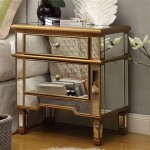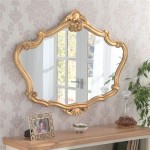Best Way to Frame a Mirror: A Comprehensive Guide
Framing a mirror enhances its aesthetic appeal and integrates it seamlessly into the surrounding décor. A well-chosen frame can transform a plain mirror into a statement piece, adding personality and style to any room. Selecting the appropriate framing method involves considering various factors, including the mirror's size, shape, and the overall design of the space. This article outlines the best practices for framing a mirror, detailing both DIY approaches and professional installation techniques.
Understanding the Different Framing Options
Several framing options exist, each with its own advantages and disadvantages. The choice depends largely on the desired aesthetic, the skill level of the installer, and budget constraints. Common framing methods include using pre-made frames, custom-built frames, and frameless mounting with decorative edges.
Pre-made frames offer convenience and affordability. These frames are readily available in various sizes, styles, and materials at most home improvement stores and online retailers. However, finding a pre-made frame that perfectly matches the mirror's dimensions can be challenging. Minor size discrepancies may necessitate adjustments or the use of fillers to ensure a snug fit.
Custom-built frames provide unparalleled flexibility in design and sizing. This option allows for precise measurements and the selection of specific materials and finishes to complement the existing décor. While custom framing offers the best aesthetic outcome, it is typically more expensive and may require professional assistance.
Frameless mounting, sometimes considered a framing alternative, involves attaching the mirror directly to the wall using specialized adhesives or mounting clips. This approach is ideal for minimalist designs and modern spaces. Decorative edges, such as beveling or etching, can be added to the mirror itself to create a subtle yet elegant frame effect. Though technically frameless, the decorative edge serves a similar visual function. This method often requires specialized tools and skills to ensure safe and secure installation, especially with larger or heavier mirrors.
Preparation and Measurement: The Foundation for Success
Proper preparation is crucial for a successful mirror framing project. Accurate measurements are essential, regardless of the chosen framing method. Before purchasing or constructing a frame, meticulously measure the mirror's width, height, and thickness. These dimensions will determine the size of the frame needed and the type of mounting hardware required.
When using a pre-made frame, ensure that the interior dimensions of the frame slightly exceed the mirror's measurements. This additional space allows for minor adjustments and prevents the mirror from being too tightly squeezed within the frame. If the frame is slightly too large, use foam or felt pads to fill the gaps and secure the mirror in place.
For custom-built frames, precise measurements are even more critical. Create a detailed diagram of the mirror and frame, including all dimensions and angles. This diagram will serve as a blueprint for cutting and assembling the frame materials. Double-check all measurements before cutting any materials to avoid costly errors.
Before starting the framing process, clean the mirror thoroughly with a glass cleaner and a lint-free cloth. This will remove any dirt, dust, or fingerprints that could interfere with the adhesive or mounting hardware. Allow the mirror to dry completely before attaching the frame.
Installation Techniques: DIY vs. Professional Assistance
The installation process varies depending on the chosen framing method and the installer's skill level. Simple framing projects, such as attaching a pre-made frame to a small mirror, can often be completed as a DIY project. More complex installations, such as custom-built frames for large mirrors, may require professional assistance.
To install a pre-made frame, carefully position the mirror within the frame and secure it using mirror clips, adhesive, or a combination of both. Mirror clips provide mechanical support and prevent the mirror from slipping out of the frame. Adhesive can provide additional security and prevent the mirror from rattling within the frame. Use a mirror-specific adhesive that is compatible with the frame material to avoid damage or discoloration.
When installing a custom-built frame, assemble the frame pieces using wood glue, screws, or nails. Ensure that the joints are strong and secure before attaching the mirror. Apply a thin bead of mirror-specific adhesive to the back of the frame and carefully press the mirror into place. Use clamps to hold the mirror in place while the adhesive dries.
For frameless mounting, use specialized mirror adhesive or mounting clips designed for this purpose. Follow the manufacturer's instructions carefully to ensure a secure and lasting bond. When using adhesive, apply it in a consistent pattern to the back of the mirror and press it firmly against the wall. Use temporary supports, such as painter's tape or shims, to hold the mirror in place while the adhesive cures.
Professional installation is recommended for large or heavy mirrors, as well as for complex framing projects that require specialized tools or skills. A professional installer will have the experience and expertise to ensure that the mirror is properly framed and securely mounted, minimizing the risk of damage or injury.
Choosing the Right Materials and Finishes
The choice of materials and finishes significantly impacts the overall aesthetic of the framed mirror. Select materials that complement the existing décor and suit the style of the room. Common frame materials include wood, metal, and synthetic polymers.
Wood frames offer a classic and versatile look. They can be stained, painted, or left natural to match any color scheme or design style. Wood frames are available in a wide variety of profiles and sizes, allowing for customization to suit any mirror. Hardwoods, such as oak, maple, and cherry, are durable and long-lasting options. Softwoods, such as pine and fir, are more affordable but may require more maintenance.
Metal frames offer a sleek and modern look. They are typically made of aluminum, steel, or brass and can be finished in a variety of colors and textures. Metal frames are durable and resistant to moisture, making them suitable for bathrooms and other humid environments. Brushed metal finishes, such as brushed nickel or brushed stainless steel, are popular choices for contemporary spaces.
Synthetic polymer frames offer a cost-effective and lightweight alternative to wood and metal. These frames are typically made of polystyrene or polyurethane and can be molded into a variety of shapes and sizes. Synthetic polymer frames are resistant to moisture and insects, making them suitable for any room in the house. They can be painted or finished to resemble wood or metal.
Consider the finish of the frame carefully. Matte finishes offer a subtle and understated look, while glossy finishes provide a more reflective and glamorous appearance. Distressed finishes add character and charm to rustic or vintage-inspired spaces. The finish should complement the other elements in the room, such as the wall color, furniture, and accessories.
Ultimately, the best way to frame a mirror involves careful planning, precise measurements, and the selection of appropriate materials and installation techniques. Whether opting for a DIY approach or professional assistance, prioritizing quality and attention to detail will result in a beautifully framed mirror that enhances the aesthetic of any space.

3 Ways To Frame A Mirror Wikihow

How To Frame Out That Builder Basic Bathroom Mirror For 20 Or Less

The Four Best Ways To Frame A Mirror

Diy Stick On Mirror Frame Sawdust Sisters

Iheart Organizing Diy Wood Framed Mirror

Mirror Frame Diy How To Update A Basic Bathroom Our Faux Farmhouse

How To Frame A Mirror With Tile

How To Frame Out That Builder Basic Bathroom Mirror For 20 Or Less

Mirror Frame Diy How To Update A Basic Bathroom Our Faux Farmhouse

Crafty Again








